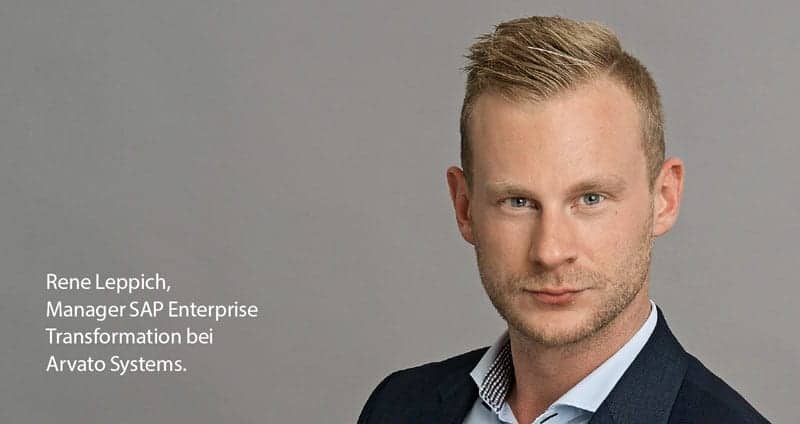S/4 Hana Lessons Learned
![[shutterstock: 141840814, Anna-Mari West]](https://e3mag.com/wp-content/uploads/2020/11/shutterstock_141840814.jpg)

Rather, the digital transformation is completely redefining relationships in the working world, both within organizations and with stakeholders such as customers and suppliers. It is a matter of rethinking the processes in companies and achieving a strategic readiness for change among all those involved.
Having the courage to change paradigms
For their medium- and long-term competitiveness, companies need to be very agile in responding to changes in the market and interconnecting players at every level so that everything - from the actions of employees to the technologies used and the operational processes - serves to achieve the strategic business goals. To do this, they need a very powerful ERP system, such as SAP S/4 Hana. In the meantime, numerous SAP customers have switched to S/4. Arvato Systems has accompanied many of them in this transformation process and gained extensive experience, which is reflected in the following eight tips.
The digital transformation is by no means exhausted by the introduction of corresponding software systems, but above all completely reorganizes business relationships, corporate processes and value chains. The corresponding software supports or accelerates this path - but is primarily a means to an end. Business transformation affects all functions, modes of action and areas within the company. Companies are therefore required not only to put tried-and-tested structures and business models to the test, but also to question existing processes, technologies and ways of thinking.

The introduction of S/4 offers the best opportunity for this. It should therefore by no means be understood as a pure IT project, but as a change project that affects the entire company. In this context, managers are called upon to give employees the freedom to come up with creative ideas. Management must make a clear commitment to being open to new approaches in principle. Last but not least, any silo thinking in the company must be a thing of the past.
A particularly large number of mistakes can be made in communication: Communication is inadequate, too late or in the wrong way. Change can only be implemented effectively and efficiently if companies involve employees right from the start. The more transparent internal communication is, and the goals and challenges are communicated in equal measure, the greater the willingness of employees to participate.
Both the content and the formats must fit the respective target group. In order to benefit comprehensively from the competencies of individual employees, one should not only rely on top-down communication, but promote the vertical exchange of information within the workforce.
Turning skepticism into commitment
The introduction of new software is almost always associated with reservations. What will I really get out of it in my day-to-day work? How complicated will the program be to use? Do I have to reckon with additional workload? With the digital transformation and the associated automation of processes, some people are also concerned about their own jobs. With realism and transparency, however, these fears can usually be dispelled by showing teams, but also individuals, how their workplace will actually change and what new opportunities it will offer them.
Especially when it comes to S/4 Hana, the business departments also benefit from the platform's standardized processes and consistent data. Controlling, for example, can be sure that it is working with standardized and always up-to-date data. On the plus side, there are also flexible, high-performance analysis and reporting functions.
In addition, decisions can now be made better and faster because the information is available in real time. Or take Digital Manufacturing as another example: In the manufacturing area, the focus is on making production more flexible so that you can react more quickly and shorten production cycles. This is achieved with S/4, which links production planning with the ERP system and has integrated functions for inventory management, material requirements planning and scheduling.
Avoid isolated solutions
Due to the extensive functionalities for data processing, the departments are able to create a wide variety of applications directly on the Hana platform.
The rollout of S/4 Hana is highly complex. Not only because a very large number of users are affected and there are strict time and budget targets as well as high quality requirements, but also because you want to keep disruptions to ongoing business operations as low as possible. In addition, there must be no breakdown in terms of ERP software. Very good strategic and organizational preparation is therefore required.
All fundamental decisions should be made in advance, such as the question of "make or buy": After all, processes that are outsourced do not have to be migrated to the new platform in the first place. Furthermore, every relevant process, the entire corporate structure and all fundamental guidelines should be checked in advance to see whether they really do contribute stringently to the company's goals and where there is potential for optimization. What is possible should already be worked through before the actual changeover. This includes, among other things, putting master data in order and archiving legacy data.
The fact that it is an innovative, well-designed solution is not sufficient as a criterion for introducing a cutting-edge technology such as AI (artificial intelligence). You have to make it usable for the department with real use cases. In addition, the cost-benefit ratio must be right. AI, for example, can relieve the accounting department of routine tasks, such as when it checks cost centers for anomalies or takes over the automated processing of incoming invoices by assigning accounts on the basis of historical data.
The demands on the IT department have changed significantly. It is no longer just an internal technological service provider that ensures that information and communications technology runs smoothly, that efficiency gains are achieved through IT, and that data protection and security are guaranteed.
Increasingly, the IT team is finding itself in the role of idea generator for new, digital business models. It should see itself as a central shaping element of corporate development and provide impetus for strategic alignment. Employees must be sensitized and trained for this. Their expanded area of responsibility and its significance must be clearly communicated within the organization.
Business transformation has many dimensions - from a change in the basic approach and workflows to a changed network of relationships and the rollout of software systems. Numerous complexity drivers, such as the balance between standardization and individualization or the new models for collaboration between IT and business departments, do not make the transformation process any easier. It is therefore helpful to plan it with the help of a roadmap and to structure it well.







